Crusty Artisan Bread
This post may contain affiliate links. Read my full disclosure policy.
This crusty bread recipe is astonishingly easy—no kneading required—and makes three beautiful loaves, which you can bake as needed.
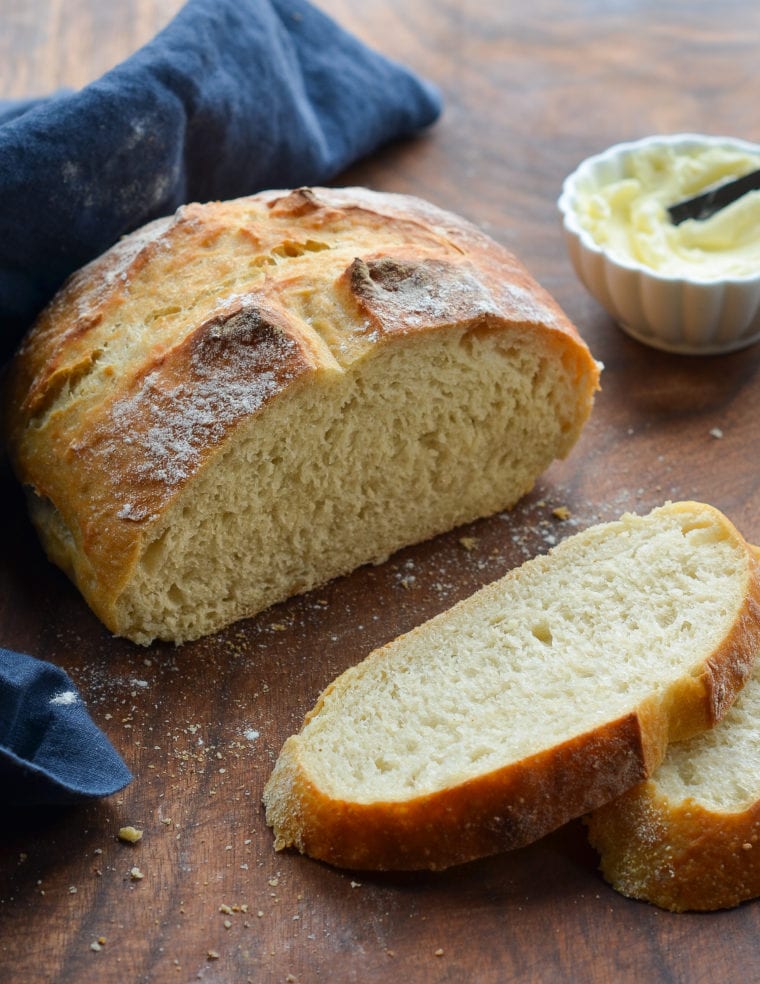
This homemade artisan bread recipe is astonishingly easy, and it makes enough for three delicious loaves, which you can bake as needed. What’s more, the dough takes just five minutes to make, does not require kneading or any special equipment, and can rest in the fridge for up to two weeks (the flavor becomes more complex the longer it sits). The recipe is modestly adapted from one of my favorite baking books, Artisan Bread in 5 Minutes A Day by Jeff Hertzberg M.D. and Zoë François.
What You’ll Need To Make Crusty Artisan Bread
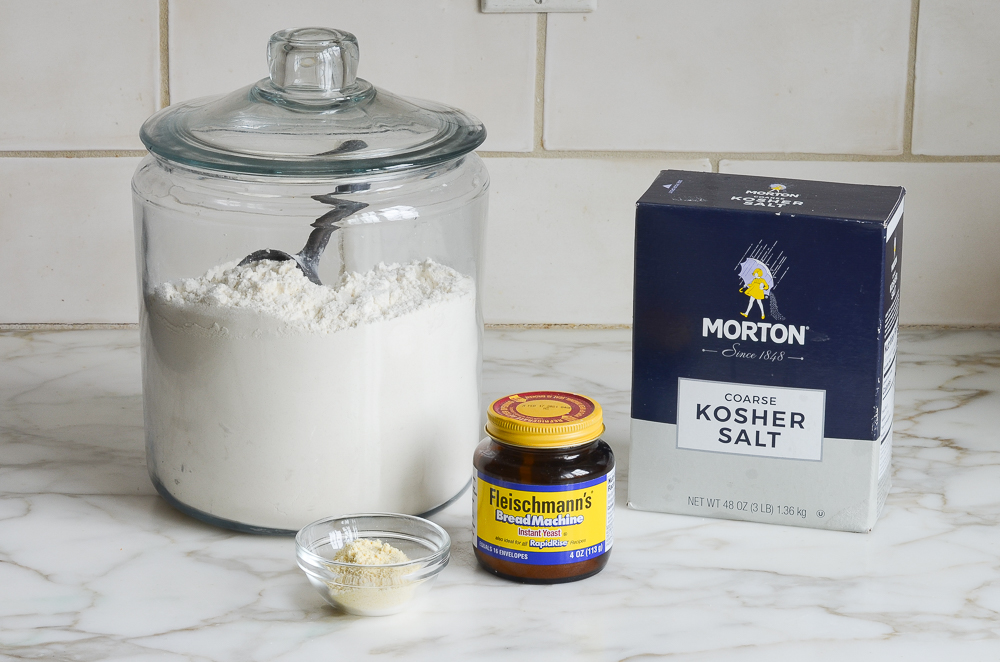
- All-purpose flour: Forms the structure of the bread; using high-protein flour, such as King Arthur, yields better results. If using a lower-protein flour, you may need to add a few more tablespoons of flour.
- Kosher salt: Enhances flavor and controls yeast activity; essential for a well-balanced taste.
- Instant/rapid-rise yeast: Leavens the dough, helping it to rise quickly without needing to activate it in water beforehand. Active dry yeast can be used instead, but it requires longer rising time. To activate, dissolve it in lukewarm water and let it sit until frothy before adding to the flour mixture.
- Lukewarm water: Hydrates the flour and yeast, helping to create the right dough consistency; lukewarm water (about 100°F) is ideal for activating the yeast.
- Cornmeal: Used for dusting the baking sheet to prevent the dough from sticking and to add a slight crunch to the crust.
- Jump to the printable recipe for precise measurements
Step-by-Step Instructions
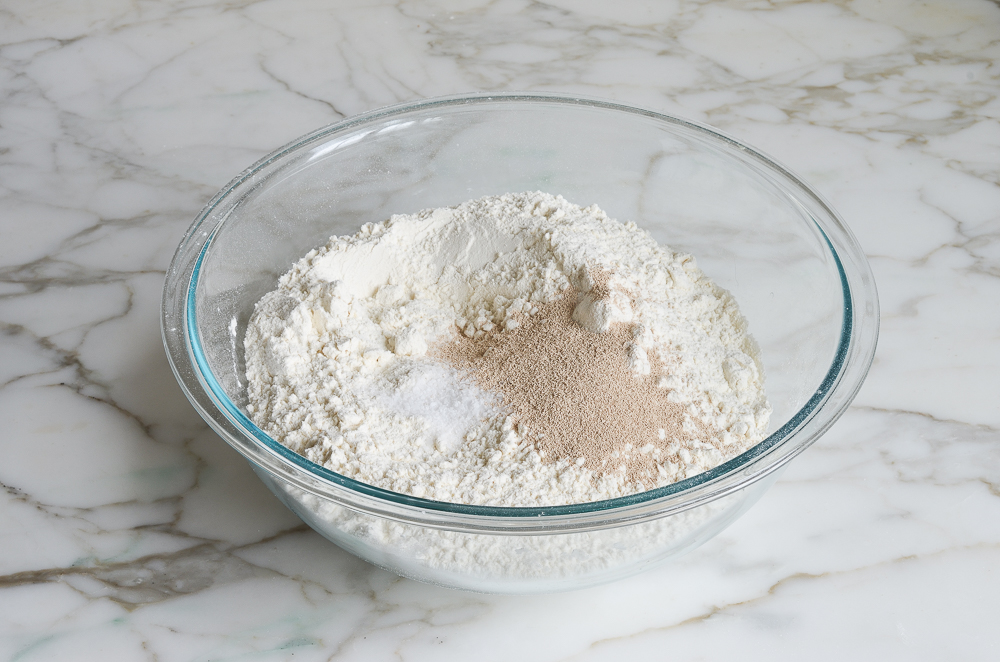
In a very large (6-quart) bowl, combine the flour, salt, and yeast. Mix to combine.
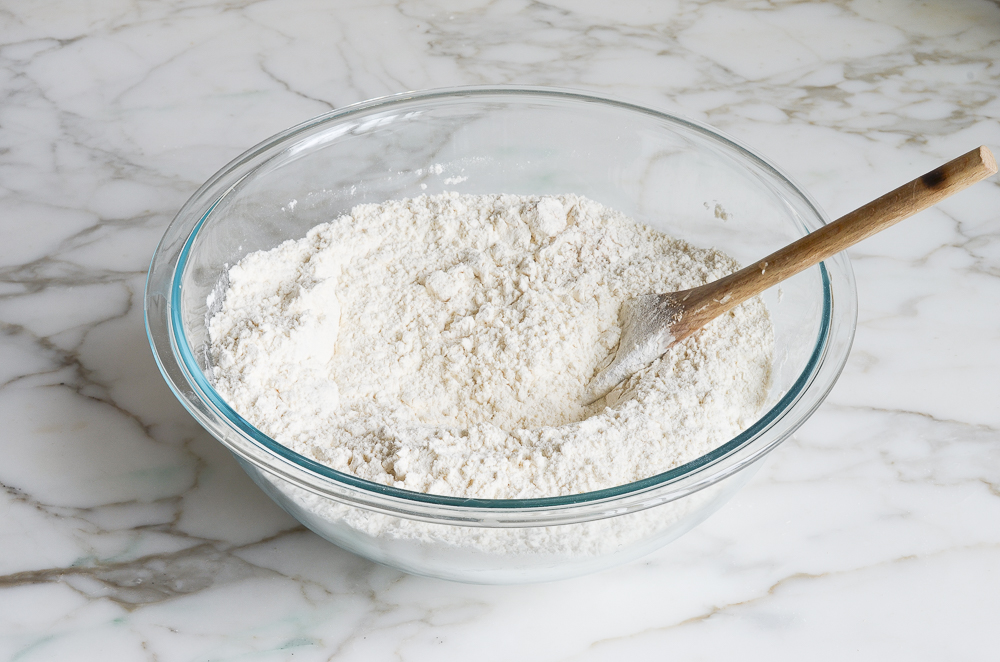
Add 3 cups of lukewarm water (no need to be exact but lukewarm is about 100°F).
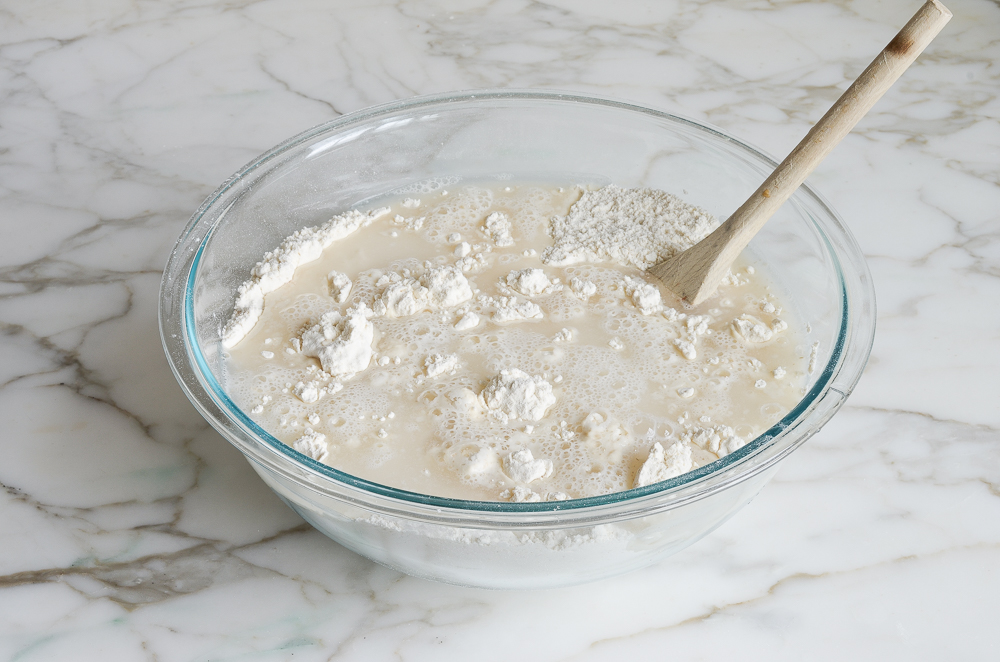
Stir with a wooden spoon until the mixture is uniformly moist, without any patches of flour.
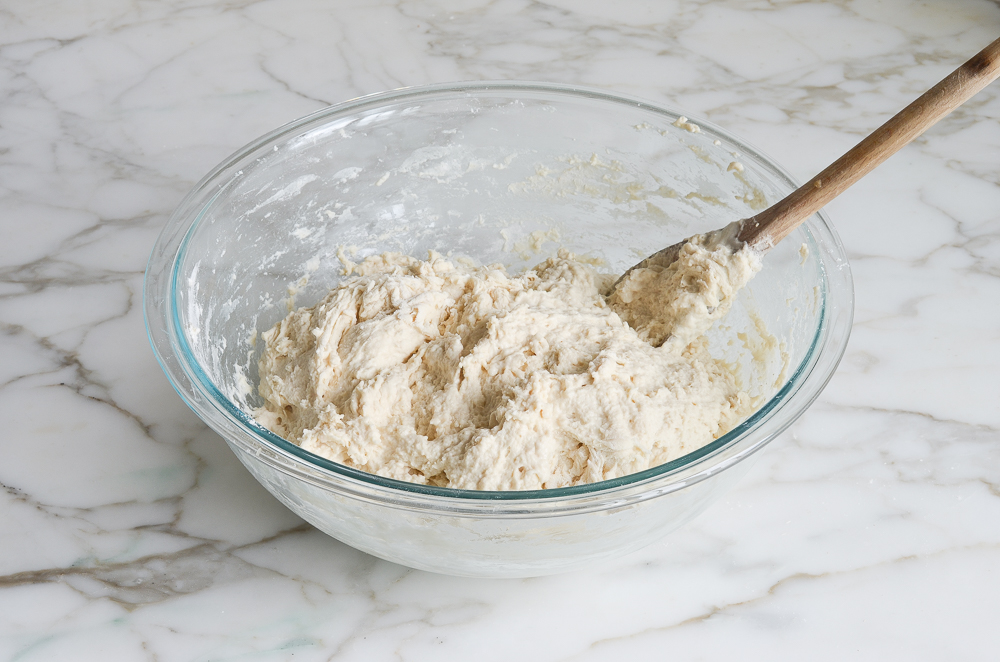
The dough should be sticky and conform to the shape of the bowl. If your dough is too dry, add a few tablespoons more warm water. If it’s too wet, add a few tablespoons of flour. Cover the bowl loosely with plastic wrap and let it sit on the counter in a warm spot for 2 hours. As you can see below, it will rise a lot!
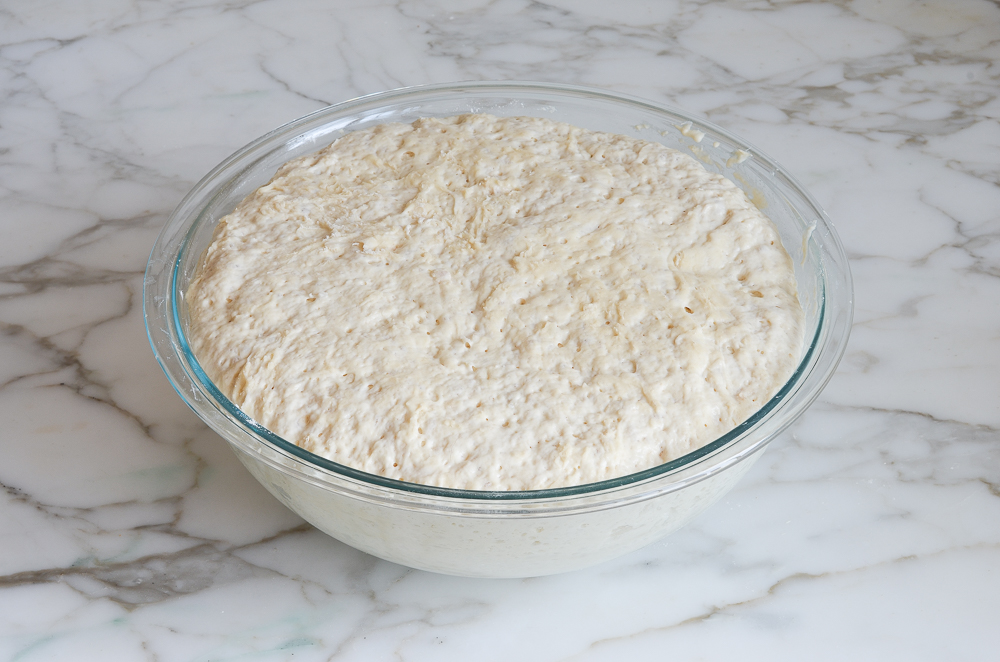
When you’re ready to bake a loaf, pull out one-third of the dough.
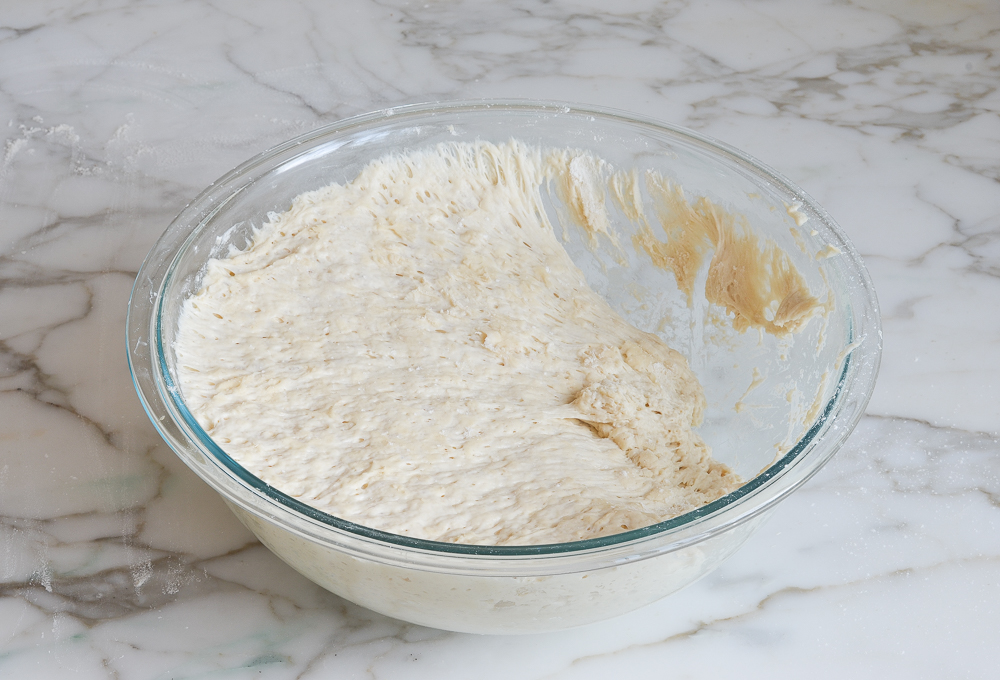
Coat the outside lightly with flour (you don’t want to incorporate more flour into the dough, you just want to be able to handle it). Gently work the dough into a smooth ball, stretching the surface and tucking the ends underneath.
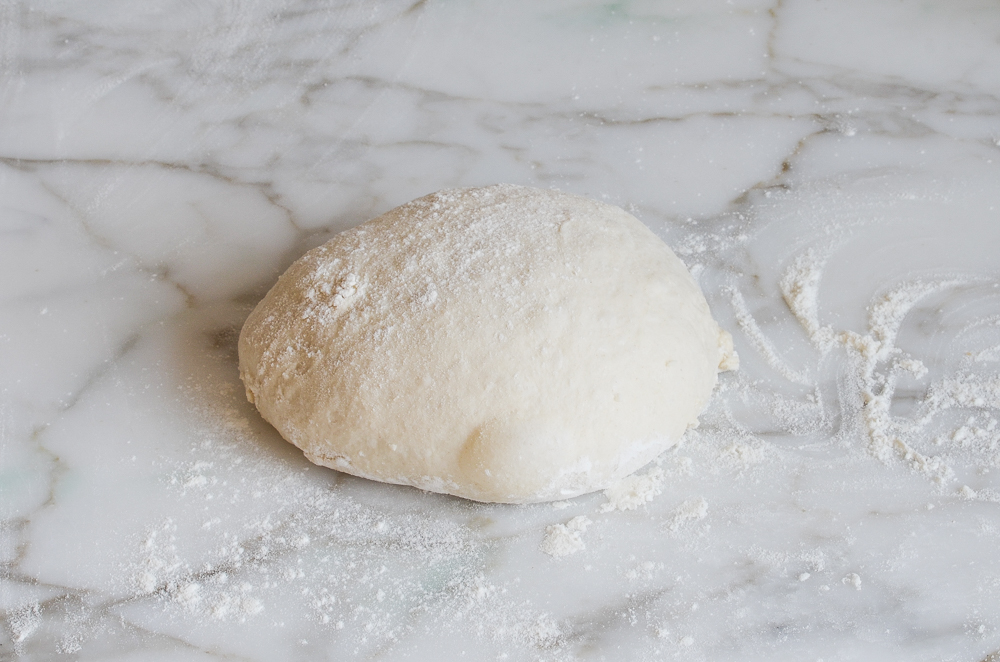
Put the dough ball onto a cornmeal-dusted baking sheet and let rest at room temperature, uncovered, for about 40 minutes. (If the dough has been refrigerated, allow it to rise for 60 minutes, or up to 90 minutes if you want a more open and airy crumb structure.) The dough will rise a bit. It may also spread/flatten a bit; that’s okay.
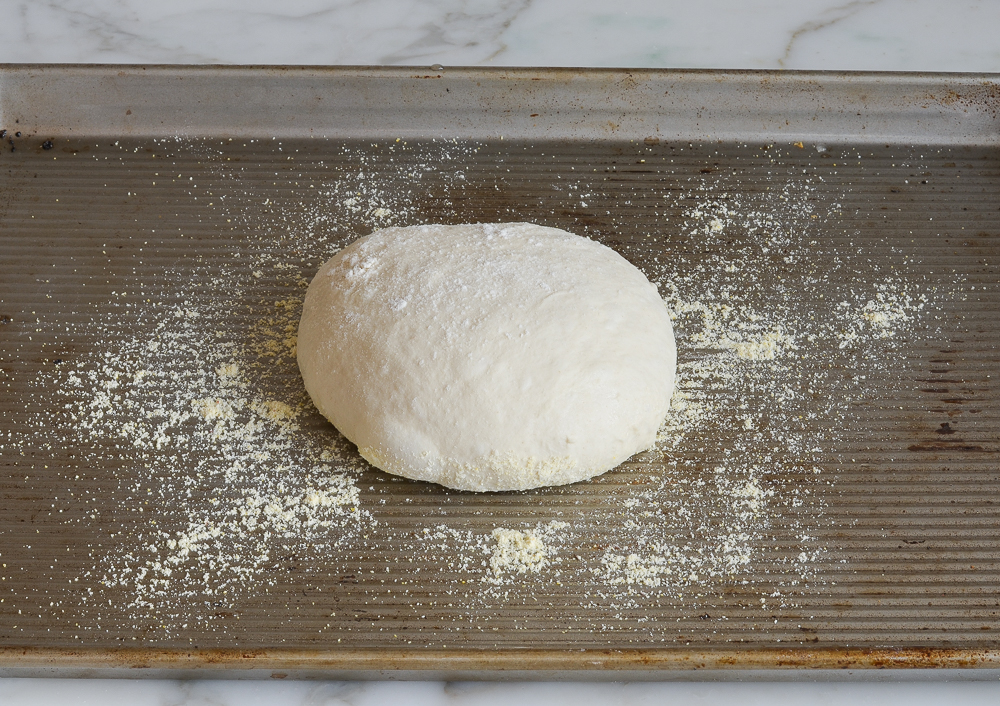
The dough will rise a bit.
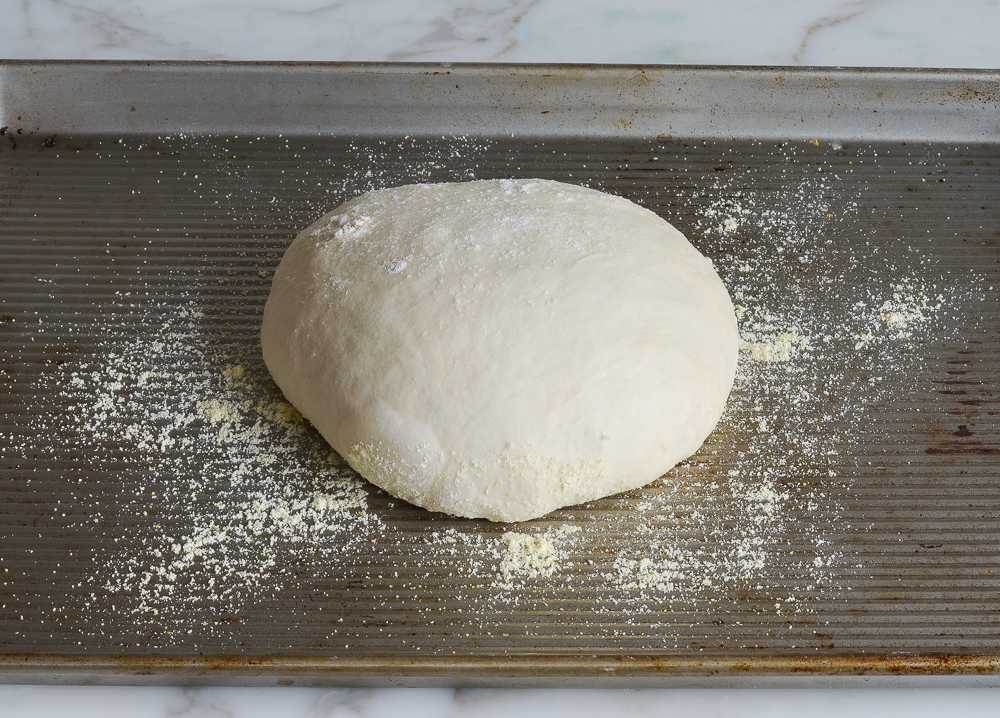
Generously dust the dough with flour. Using a sharp knife, make a few 1/2-inch-deep slashes in the dough — a scallop, cross, or tic tac toe pattern all look nice.
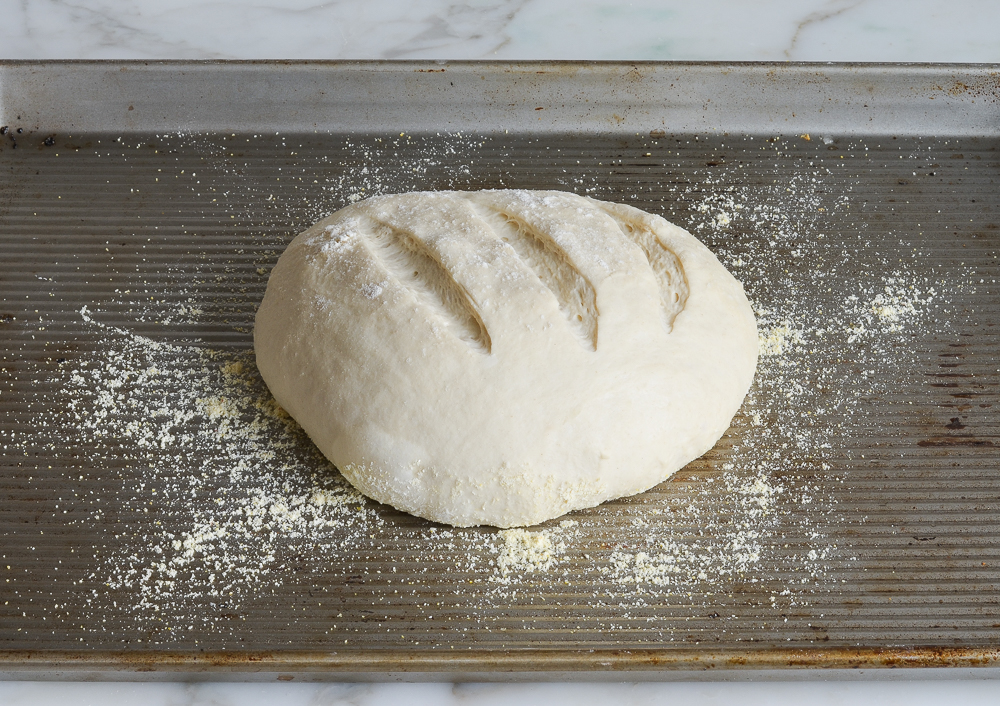
Set a metal pan on the bottom rack of a preheated 450°F-oven. Slide the baking sheet with the dough into the oven, and carefully fill the metal cake pan with one cup of hot tap water. This creates steam in the oven. (Try to do this quickly so as not to let heat out of the oven.) Bake until the loaf is golden brown, about 30 minutes. Cool completely on a wire rack.
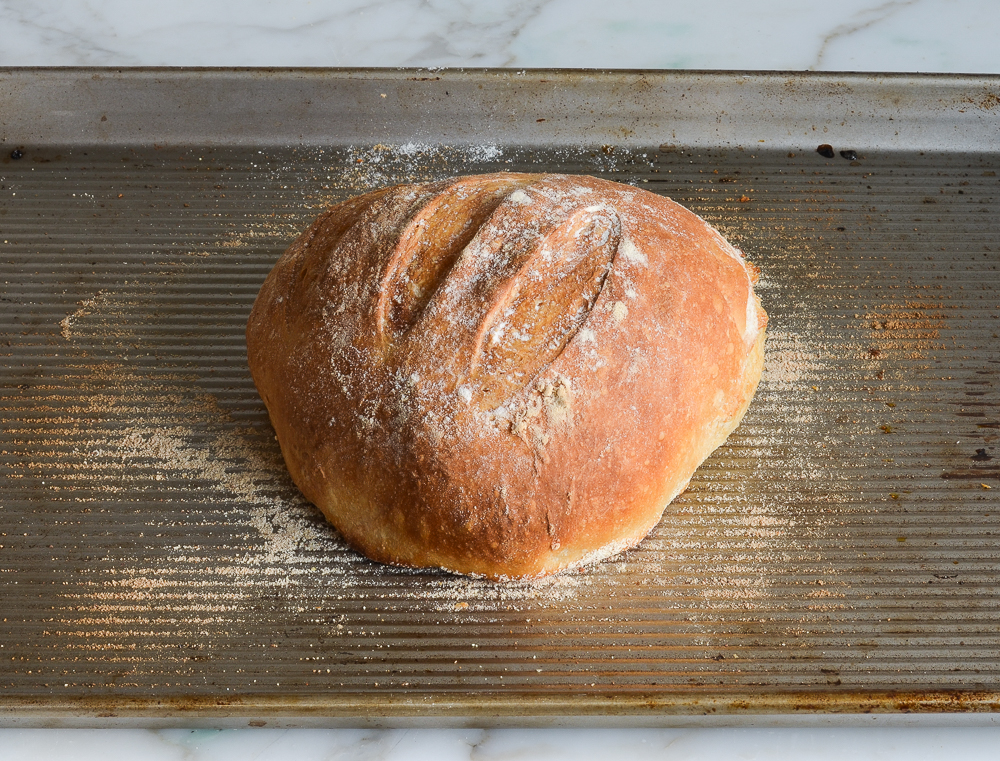
This bread is best enjoyed fresh on the day it is made. Once sliced, place the loaf cut-side down on a cutting board or plate and leave it uncovered.
Freezing Instructions
The dough can be portioned into thirds and frozen in airtight plastic containers for up to 1 month. Defrost the dough in the refrigerator overnight, then shape, rest and bake as usual. The baked loaves can also be frozen whole or sliced. Wrap in a zip-top freezer bag and freeze for up to 1 month. To thaw, take the bread out of the freezer and let it come to room temperature, about 3 hours. Reheat in a 350°F oven until warmed through, about 10 minutes.
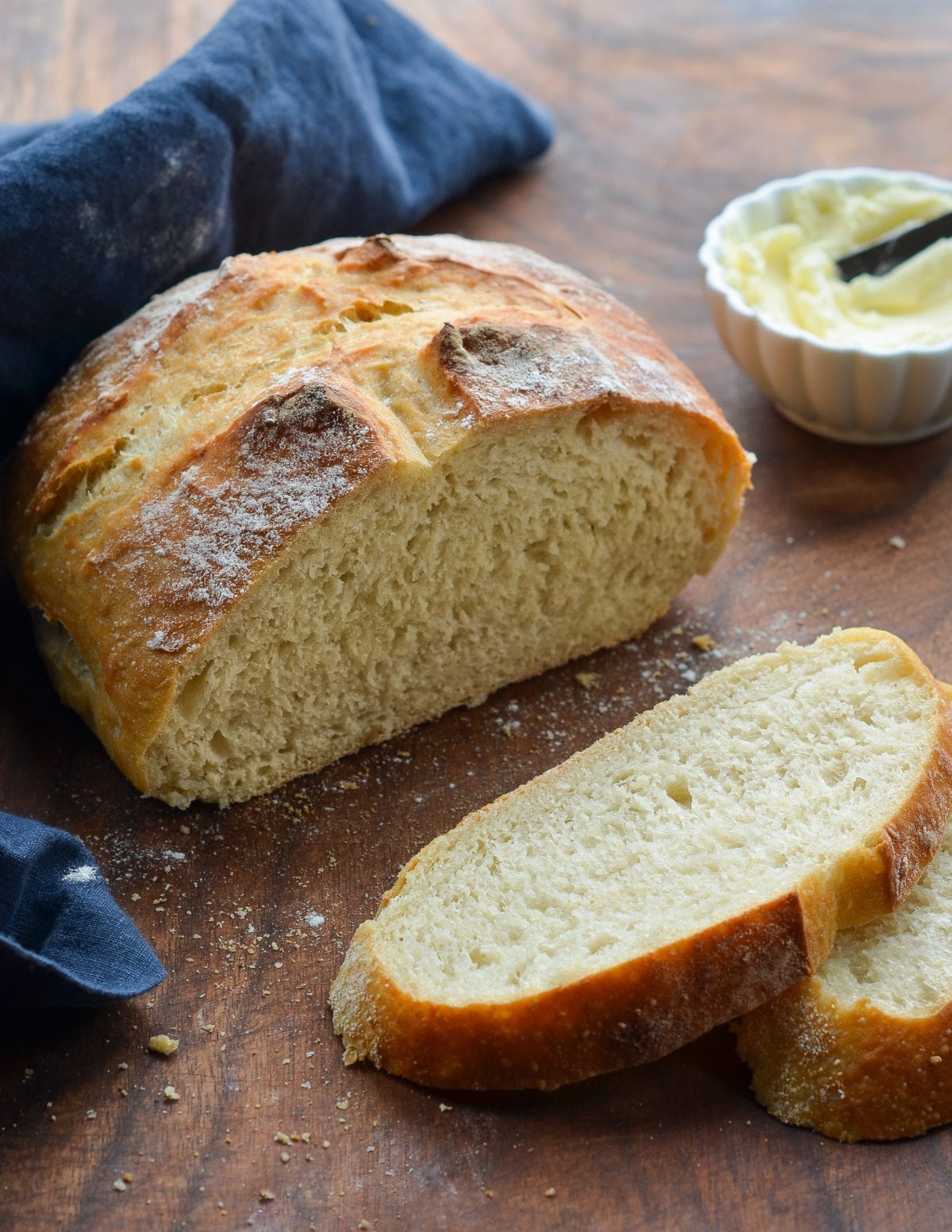
You May Also Like
Artisan Bread
This crusty bread recipe is astonishingly easy—no kneading required—and makes three beautiful loaves, which you can bake as needed.
Ingredients
- 6½ cups all-purpose flour, spooned into measuring cup and leveled-off (preferably King Arthur; see note)
- 4 teaspoons kosher salt
- 1½ tablespoons instant/rapid-rise yeast (see note)
- 3 cups lukewarm water (no need to be exact but lukewarm is about 100°F)
- Cornmeal, for dusting the pan
Instructions
- In a very large (6-quart) bowl, whisk together the flour, salt, and yeast. Add the water and stir with a wooden spoon until the mixture is uniformly moist, without any patches of flour. The dough should be sticky and conform to the shape of the bowl. If your dough is too dry, add a few tablespoons more warm water. If it's too wet, add a few tablespoons of flour. (See the step-by-step photos for guidance on what the dough should look like.) Cover the bowl loosely with plastic wrap and let it sit on the counter in a warm spot for 2 hours. If you plan to bake a loaf immediately, proceed to the next step. Otherwise, place the bowl of dough in the refrigerator to be used over the next 14 days. (Once refrigerated, the dough will shrink back a bit; that's okay. Do not punch down the dough at any point, and keep it loosely covered with plastic wrap.)
- Dust a sturdy baking sheet with cornmeal.
- Dust the surface of the dough and your hands lightly with flour. Pull out one-third of the dough and coat the outside lightly with flour (you don't want to incorporate more flour into the dough, you just want to be able to handle it). Gently work the dough into a smooth ball, stretching the surface and tucking the ends underneath, adding more flour as needed so it doesn't stick to your hands. (Don't overwork the dough; this process should only take about 30 seconds.) Put the dough ball onto the prepared baking sheet and let it rest at room temperature, uncovered, for about 40 minutes. (If the dough has been refrigerated, allow it to rise for 60 minutes, or up to 90 minutes if you want a more open and airy crumb structure.) The dough will rise a bit. It may also spread/flatten a bit; that's okay.
- Preheat the oven to 450°F. Set one rack in the lowest position of the oven and one rack in the middle position. Place a metal pan (any metal cake pan or broiler pan will work; just don't use glass) on the bottom rack. (You will fill this with water later to create steam in the oven).
- Generously dust the dough with flour. Using a sharp knife, make a few ½-inch-deep slashes in the dough -- a scallop, cross, or tic tac toe pattern all look nice.
- Slide the baking sheet with the dough into the oven, and carefully fill the metal cake pan with one cup of hot tap water. (Try to do this quickly so as not to let heat out of the oven.) Bake until the loaf is golden brown, about 30 minutes. Cool completely on a wire rack.
- This bread is best enjoyed fresh on the day it is made. Once sliced, place the loaf cut-side down on a cutting board or plate and leave it uncovered. (If it lasts beyond a day, I suggest slicing and freezing.)
- Freezer-Friendly Instructions The dough can be portioned into thirds and frozen in airtight plastic containers for up to 1 month. Defrost the dough in the refrigerator overnight, then shape, rest and bake as usual. The baked loaves can also be frozen whole or sliced: Wrap in a zip-top freezer bag and freeze for up to 1 month. (If you plan to use slices one at a time, place pieces of parchment between them so they don't stick.) To thaw, take the bread out of the freezer and let it come to room temperature on the countertop. Reheat in a 350°F oven until warmed through, about 10 minutes.
- Note: Active dry yeast may be used instead of instant/rapid-rise yeast, however, the dough will take longer to rise. To give active dry yeast a boost, you can dissolve it in the lukewarm water and let it sit until frothy, about 10 minutes. After that, add it to the flour and salt, and proceed with the recipe.
- Note: I use King Arthur flour, which is higher in protein than some other all-purpose flours. If using a flour with a lower protein content, such as Gold Medal, you will likely need to add a few more tablespoons of flour.
Nutrition Information
Powered by ![]()
- Serving size: 1 slice
- Calories: 100
- Fat: 0 g
- Saturated fat: 0 g
- Carbohydrates: 21 g
- Sugar: 0 g
- Fiber: 1 g
- Protein: 3 g
- Sodium: 64 mg
- Cholesterol: 0 mg
This website is written and produced for informational purposes only. I am not a certified nutritionist and the nutritional data on this site has not been evaluated or approved by a nutritionist or the Food and Drug Administration. Nutritional information is offered as a courtesy and should not be construed as a guarantee. The data is calculated through an online nutritional calculator, Edamam.com. Although I do my best to provide accurate nutritional information, these figures should be considered estimates only. Varying factors such as product types or brands purchased, natural fluctuations in fresh produce, and the way ingredients are processed change the effective nutritional information in any given recipe. Furthermore, different online calculators provide different results depending on their own nutrition fact sources and algorithms. To obtain the most accurate nutritional information in a given recipe, you should calculate the nutritional information with the actual ingredients used in your recipe, using your preferred nutrition calculator.

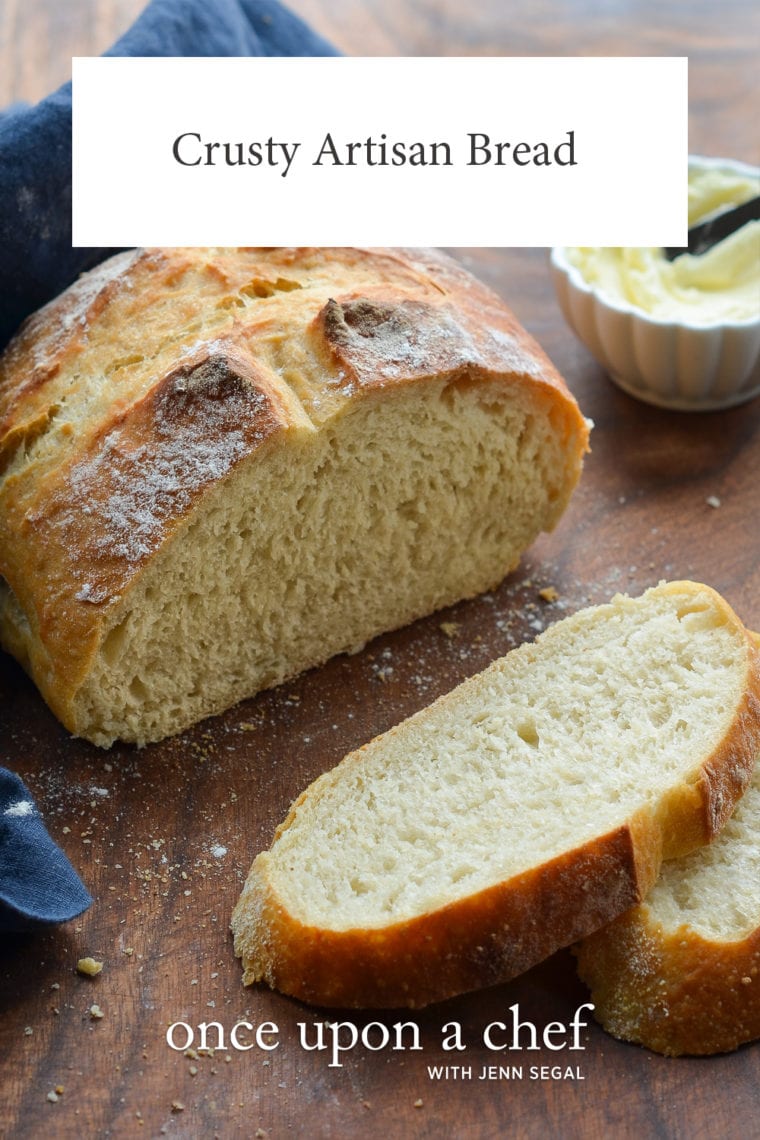
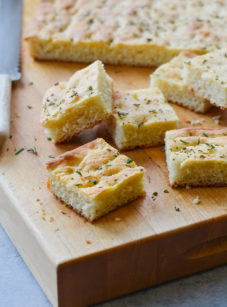
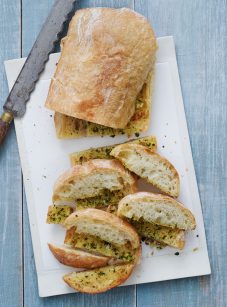
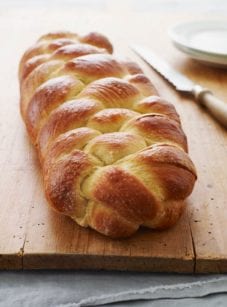
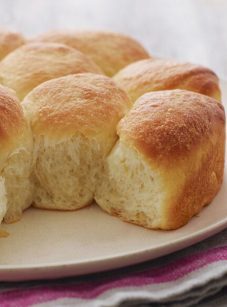
Can you bake two loaves at the same time, and if so, do you add twice the water in the pan? Or what are the instructions?
Hi Joanne, You can definitely bake two loaves at once; no need to double the water. They may take a few extra minutes in the oven. Just use the color as a visual cue–you’re looking for a golden brown. 🙂
I’d like to add shredded cheese, garlic and spices like Herbes de provence but don’t know how much. Please advise, Thank you
Hi Jerry, I’ve never tried adding anything to the dough so I can’t say for sure, but I’d start conservatively — maybe 1/2 cup of cheese and a tablespoon of minced garlic and herbes de Provence. Please LMK how it turns out if you try it with these additions!
For the three loaves I ground up a tablespoon of Herbes de Provence along with 1/8 tsp. garlic powder or more to your liking. I also added 1/8 tsp, of onion powder and you can add more. I added 2 cups total shredded cheese, cheddar and asiago and parmesan. Add Herbs and cheeses to the liquid and add flour last. Nice aroma as it was baking and it tastes delicious!
So glad it came out nicely — thanks for taking the time to report back!
I would like to make a tasty spice version of this delicious recipe.
Best crusty bread ever! Total of 4 ingredients plus cornmeal to dust the pan, makes 3 loaves! Great for a few days of fresh, delicious bread (except that it’s so good it’s hard to resist eating it!) So glad I found this recipe!
If you are using a Dutch oven. How long do you bake it covered and then uncovered?
Hi Denise, You can bake it in a Dutch oven just as the recipe indicates; I’d keep it covered for 20 minutes and then remove the lid for the last 10 minutes of baking. Hope you enjoy!
Hi Jenn!
Quick question………Can I use KA bread flour instead of all purpose flour?
Thank you! Love all of your recipes!
Hi Suzanne, Yes bread flour will work and will give the bread a chewier texture.
Thanks for your quick response.
I’ve been using this recipe for a couple of years now so thought I better leave a review. Easiest bread to make and is guaranteed to taste delicious!
Perfect bread. I have made this 4 times. Each time I adjust something. It is so good. I learned to top the bread with foil if it was browning too quickly, I learned to not add flaked salt until right before baking, I learned to have safety space when pouring water to inspire a crisp top. Yum
Hi Jenn. Could I use a sourdough starter instead of yeast for this recipe? If yes, how much starter would you recommend I use? Thank you so much!
Hi Sam, I’ve never used a sourdough starter for this so I’d be reluctant to recommend it without trying it — sorry!
Hi Jen. Love this bread, on our 6th loaf in 3 weeks! Turkey and Swiss sandwiches are so much more delicious!
I’m having difficulty finding a 6 qt bowl that isn’t plastic. Where did you purchase yours? My largest Pyrex is 4 qt and what I’ve been using. The dough rises up over the top of the bowl and not certain how this affects the bread, texture etc?
Kristy
Hi Kristy, I would recommend a bowl large enough that the dough doesn’t rise over the top. I see a few 6-quart bowls on Amazon that would work. See the first 2 rows on this page.
Oh I thought the bowl needed to be metal or glass for best result?
Any material bowl will work (including plastic). Hope that clarifies!
This was my first time trying to make artisan bread and all three loaves came out perfect. I can’t wait to finish these and try to make a cinnamon raisin swirl and the cheese and herbs one mentioned above. Thank you so much for this recipe, it is soo good!!
I have been making your bread for three years now and it’s amazing. I use three cast iron loaf pans (with a tiny bit of olive oil to coat pans) to bake the bread and otherwise follow your recipe exactly. We can’t ever go back to any other kind of bread. Thank you!